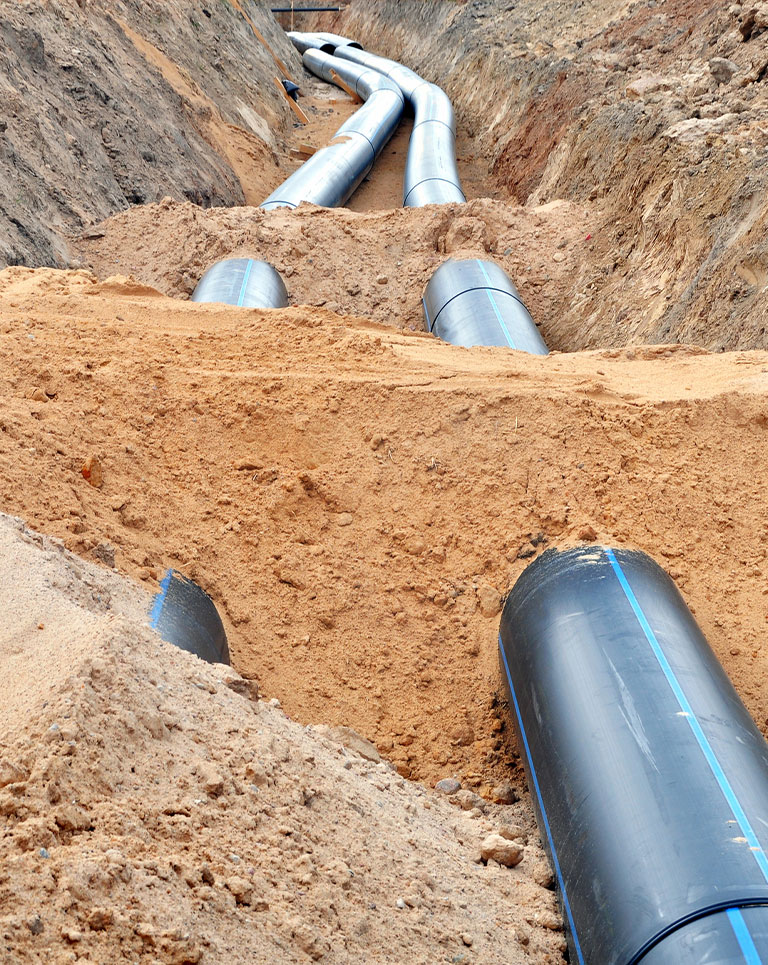Underground Conduit Construction for Power, Fiber & Utility Infrastructure
Crigger Power builds utility-grade conduit systems across active job sites, developed land, and hard-to-access corridors without outsourcing or slowing the schedule. We install power, fiber, and telecom conduit using a mix of trenchless boring and conventional trenching based on site conditions and utility depth.
Crigger crews handle every conduit construction project using in-house equipment and field-tested methods. We drill, trench, and place conduit systems beneath roads, rail lines, parking lots, and foundations while protecting the surface and locking in grade.
Crigger Power gets it in the ground and does it right for conduit installation, which demands precision, speed, and zero handoffs.
Why Contractors Choose Crigger for Conduit Construction
Crigger Power builds complete underground systems that meet spec, hold grade, and stay on schedule. Contractors call us when surface disruption isn’t an option, when deadlines are tight, or when the job demands a crew that knows how to handle it in the dirt.
Every conduit install is done in-house using Crigger-owned gear and experienced crews who’ve worked across roadways, rail lines, utilities, and tight-access sites. We adjust trenching depth, spacing, and method to match the utility type and ground conditions without passing the work off to someone else.
When the job calls for clean conduit runs, fast timelines, and zero handoffs, Crigger Power gets it done right.

Utility Boring Services That Keep Conduit Projects Moving
Conduit construction often overlaps with complex utility bores, and Crigger Power is built for both. We match each boring method to the job’s exact requirements, accounting for depth, grade, ground conditions, and what’s overhead. Every utility crossing is handled in-house by Crigger crews using our own rigs, whether the bore runs beneath a road, rail line, or developed site.
These services support underground utility builds, helping power, telecom, fiber, and drainage systems stay protected, aligned, and on schedule.
Nationwide Conduit Construction FAQs
Installing conduit underground requires more than trenching and pipe—it requires the right method, spacing, and crew that knows how to stay on grade while keeping the surface intact. That’s why contractors reach out to Crigger Power early in the process. We build conduit systems that meet spec, meet code, and avoid the delays that come with subs or guesswork.
Here are the most common questions we get about conduit construction, trenchless installations, and how we handle jobs that need to move fast and finish clean. For deeper insights, visit our full FAQs and Blog page.
Conduit construction refers to the installation of underground piping systems that carry utilities like power, fiber optics, and telecom. These systems are placed before the utility lines are pulled or placed inside, creating a protected pathway that keeps cables safe and accessible. Crigger Power installs conduit for electric service, broadband infrastructure, communication lines, and low-voltage systems.
We handle conduit construction for both single-use lines and multi-utility joint trench builds, adjusting spacing, depth, and material based on project requirements and soil conditions. Every run is installed to spec and prepped for fast, clean tie-ins.
We use both trenchless and open-cut methods, depending on the jobsite, utility depth, and surrounding infrastructure. These include:
- Trenching for long straight runs or accessible, undeveloped sites
- Horizontal boring for conduit under roads, railways, or existing foundations
- Jack and bore for larger conduit installations requiring casing or high precision
- Hand digging and vacuum excavation in tight, high-risk zones with existing utilities
Our crews select the proper method for the site, not just what’s easiest. That’s how we keep jobs moving while protecting the ground above and the utilities below.
Yes—and that’s one of our specialties. Crigger Power is often brought in when the conduit needs to go in without disrupting roads, lots, or structures already in place. We install conduit beneath highways, rail lines, commercial developments, and job sites with ongoing operations.
Our in-house teams manage every bore or trench with minimal surface disruption, coordinating with GCs, utility providers, and other trades to keep the job on track without requiring shutdowns or site delays.
We install a range of conduit sizes and materials based on the utility type, load, and site demands. Common conduit types include:
- PVC conduit for telecom and low-voltage systems
- HDPE conduit for long runs and trenchless installations
- Rigid steel or galvanized conduit for high-impact or exposed transitions
- Multiple-duct banks when housing power and fiber in the same run
Every install is engineered to match the required spec, bend radius, and separation from other utilities. We don’t cut corners—we install it the right way from pit to pullback.
Crigger Power installs conduit systems across the U.S., with fast mobilization and in-house crews handling the full job. We work on private builds, commercial sites, industrial facilities, and utility-heavy corridors where trenchless installation is key. No matter the location, we show up with the gear, the crew, and the ability to finish what others won’t.
If the project requires the placement of clean, on-time power, fiber, or telecom conduit, Crigger is ready to do it right.
Contact Crigger Power for Conduit Construction
Crigger Power installs underground conduit systems where precision matters and delays aren’t an option. We place power, fiber, and telecom conduit beneath roads, through tight corridors, and across job sites without surface damage or missed specs. Every trench or bore is managed by our in-house crews using
Crigger-owned equipment—no rentals, no subcontractors, no excuses.
We build conduit systems fast, clean, and ready to pull cable the moment the job wraps. We’re prepared if your site needs a utility conduit installed on grade and on schedule.
Contact us today and let’s start drilling it right.
